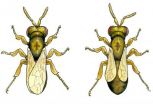(Press-News.org) CHICAGO --- Millions of "good" bacteria exist harmoniously on the skin and in the intestines of healthy people. When harmful bacteria attack, the immune system fights back by sending out white blood cells to destroy the disease-causing interlopers. But how do white blood cells know which bacteria are good and which are harmful?
Northwestern University Feinberg School of Medicine researchers studied one type of white blood cell known as a macrophage, which is among the immune system's first to detect and eliminate harmful bacteria. The research team, led by Christian Stehlik, John P. Gallagher Research Professor of Rheumatology at Feinberg, discovered that the protein NLRP7 serves as a "scout" in macrophage cells, identifying bacterial cell wall components in harmful gram-positive bacteria such as Staphylococcus aureus and Listeria monocytogenes.
The findings will be published in the February 23 issue of the journal Immunity.
"NLRP7 is a novel intracellular pattern recognition receptor that specifically recognizes bacterial cell wall components, known as lipopeptides, in harmful bacteria," says Stehlik, who worked closely with collaborators Andrea Dorfleutner, research assistant professor of medicine at Feinberg, and Yon Rojanasakul, Robert C. Byrd Distinguished Professor and Benedum Distinguished Professor at West Virgina University. "We show that activation of NLRP7 is necessary for eradicating bacterial infections through the formation of protein complexes called inflammasomes, which enable the production of defense factors in immune cells."
Identifying the molecule was complicated, says Sonal Khare, postdoctoral fellow at Feinberg and first author on the research paper, because the family of proteins within macrophages is quite large. "There were 22 likely candidates. To determine which one of these proteins is able to recognize bacteria in macrophages, we had to remove each one of them," she says. Through process of elimination, the team identified NLRP7 as the required protein.
Stehlik says the finding is significant because it contributes to a better understanding of how bacteria such as Listeria and Staphylococcus are recognized by the immune system. Listeria is found in uncooked meats, vegetables, and fruits such as cantaloupes. In 2011, listeria was the cause of the deadliest food contamination outbreak in the U.S. in more than a decade. S. aureus infections are most commonly contracted in hospitals, and 500,000 patients acquire Staphylococcus infections annually in the U.S. Methicillin-resistant S. aureus, or MRSA, strains are highly resistant to commonly-used antibiotics.
Understanding how the immune system recognizes these deadly intruders could one day lead to novel treatment strategies to combat these infections.
"The next phase of research related to NLRP7 and inflammasomes is progressing," says Stehlik. "We are continuing the research to explore mechanisms behind how this NLRP7 inflammasome is formed. We want to know whether we can manipulate this process to make the response stronger. We also will be exploring the use of mouse models in this pathway to study this response in vivo."
INFORMATION:
The article, "An NLRP7-Containing Inflammasome Mediates Recognition of Microbial Lipopeptides in Human Macrophages" will be available for download on the journal Immunity's web site.
END
Numerous mouse strains show great biological variation in features such as behavior, coat color and susceptibility to cancer and other diseases.
This study examines one possible genetic cause for differential gene expression and biological variation.
COLUMBUS, Ohio – The many short pieces of mobile DNA that exist in the genome can contribute to significant biological differences between lineages of mice, according to a new study led by researchers at the Ohio State University Comprehensive Cancer Center – Arthur G. James Cancer Hospital and Richard J. Solove Research ...
How we move is an excellent indicator of overall health. When we feel good, we move around continually. When we're in pain, we reduce our physical activity. This observation might seem trivial, but it has led to an original approach for evaluating chronic pain. A team from EPFL's Laboratory of Movement Analysis and Measurement (LMAM) has developed a clever, easy-to-use visual tool to help doctors assess their patients' pain levels. The research appears online February 23 in the journal PLoS One.
"Movement is an objective indicator of pain. You move differently if you're ...
The tiny, little-noticed jewel wasp may provide some answers as to how different species differ in size and shape. And that could lead to a better understanding of cell growth regulation, as well as the underlying causes of some diseases.
Using the wings of these insects as a tool to study how growth is regulated, biologists at the University of Rochester have discovered that changes in expression of a well-known cell regulator gene called "unpaired" (upd) accounts for wing growth differences between males of closely related species. Unpaired is distantly related to ...
Researchers at National Jewish Health have discovered specific molecular and signaling events by which vitamin D inhibits inflammation. In their experiments, they showed that low levels of Vitamin D, comparable to levels found in millions of people, failed to inhibit the inflammatory cascade, while levels considered adequate did inhibit inflammatory signaling. They reported their results in the March 1, 2011, issue of The Journal of Immunology.
"This study goes beyond previous associations of vitamin D with various health outcomes. It outlines a clear chain of cellular ...
A major register study from the Swedish medical university Karolinska Institutet shows that children born to certain groups of immigrants in Sweden had an increased risk of developing autism with intellectual disability. The study includes all children in Stockholm County from 2001 to 2007, and brings the question of the heredity of autism to the fore.
"This is an intriguing discovery, in which we can see strong links between a certain kind of autism and the time of the mother's immigration to Sweden," says principal investigator Cecilia Magnusson, Associate Professor ...
Prof. Dr. Albert Newen and Dr. Leon de Bruin from the Institute of Philosophy II at the Ruhr-Universität explain their theory in the journal Cognition. In the first year of life, children already have a basic "theory of mind", that is, they are capable of distinguishing their own beliefs from those of others. At the age of four, this capacity is fully developed. According to the Bochum model, this development is guided by two interacting systems.
Contradictory results: "false belief" test with and without language
The test: Sally puts her ball into a basket and goes ...
Some Parkinson's Disease patients can suddenly become creative when they take dopamine therapy, producing pictures, sculptures, novels and poetry. But their new-found interests can become so overwhelming that they ignore other aspects of their everyday life, such as daily chores and social activities, according to research published in the March issue of the European Journal of Neurology.
Italian researchers studied 36 patients with Parkinson's Disease - 18 with increased artistic production and 18 without - and compared them with 36 healthy controls without Parkinson's. ...
To connect a laptop to an additional monitor, projector or even to a monitor wall, a special cable was required, until now. Researchers of the Saarland University's Intel Visual Computing Institute overcome this obstacle by linking computer and monitor via an 'Internet Service'. By this means, a screen's contents can be shifted freely to any terminal's display and even shown on large-scale monitor walls. The Saarland University's scientists present their results for the first time at stand F34, in hall 9 at the computer fair Cebit. The trade show takes place in Hannover ...
A study in Spain shows that insecurity at work is directly and negatively linked to satisfaction in work and life, as well as affecting performance and commitment. Furthermore, the research reveals that the consequences of this insecurity are different according to the occupational group they work in.
A study led by Spanish psychologists has concluded that the feeling that one is going to lose their job worsens satisfaction levels in other areas of life, such as family, health, financial circumstances and the work-free time balance.
As the fear of unemployment increases ...
Bisphenol A (BPA) is a controversial chemical widely used in the plastics industry. A new study followed people over a 10-year time period and shows that healthy people with higher urine concentrations of BPA were more likely to later develop heart disease.
The study was carried out by researchers at the Peninsula College of Medicine and Dentistry, the University of Exeter and the European Centre for the Environment and Human Health, in association with the University of Cambridge. The analysis was funded by the British Heart Foundation. The paper is published online ...


